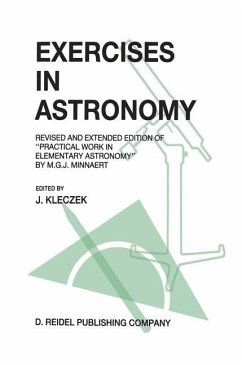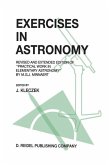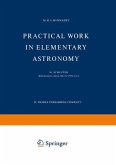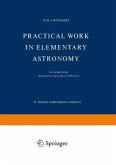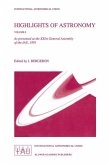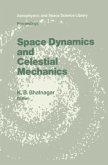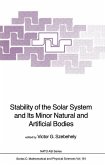J. Kleczek (Hrsg.)Revised and Extended Edition of ¿Practical Work in Elementary Astronomy¿ by M.G.J. Minnaert
Exercises in Astronomy
Revised and Extended Edition of ¿Practical Work in Elementary Astronomy¿ by M.G.J. Minnaert
Herausgeber: Kleczek, J.
J. Kleczek (Hrsg.)Revised and Extended Edition of ¿Practical Work in Elementary Astronomy¿ by M.G.J. Minnaert
Exercises in Astronomy
Revised and Extended Edition of ¿Practical Work in Elementary Astronomy¿ by M.G.J. Minnaert
Herausgeber: Kleczek, J.
- Broschiertes Buch
- Merkliste
- Auf die Merkliste
- Bewerten Bewerten
- Teilen
- Produkt teilen
- Produkterinnerung
- Produkterinnerung
Revised and Extended Edition of `Practical Work in Elementary Astronomy' by M.G.J. Minnaert
Andere Kunden interessierten sich auch für
![Exercises in Astronomy Exercises in Astronomy]() J. Kleczek (Hrsg.)Exercises in Astronomy168,99 €
J. Kleczek (Hrsg.)Exercises in Astronomy168,99 €![Practical Work in Elementary Astronomy Practical Work in Elementary Astronomy]() Marcel G. J. MinnaertPractical Work in Elementary Astronomy77,99 €
Marcel G. J. MinnaertPractical Work in Elementary Astronomy77,99 €![Practical Work in Elementary Astronomy Practical Work in Elementary Astronomy]() Marcel G. J. MinnaertPractical Work in Elementary Astronomy77,99 €
Marcel G. J. MinnaertPractical Work in Elementary Astronomy77,99 €![Highlights of Astronomy Highlights of Astronomy]() Jacqueline Bergeron (Hrsg.)Highlights of Astronomy116,99 €
Jacqueline Bergeron (Hrsg.)Highlights of Astronomy116,99 €![Long-Time Predictions in Dynamics Long-Time Predictions in Dynamics]() V.G. Szebehely / B.D. Tapley (Hgg.)Long-Time Predictions in Dynamics115,99 €
V.G. Szebehely / B.D. Tapley (Hgg.)Long-Time Predictions in Dynamics115,99 €![Space Dynamics and Celestial Mechanics Space Dynamics and Celestial Mechanics]() K.B. Bhatnagar (Hrsg.)Space Dynamics and Celestial Mechanics153,99 €
K.B. Bhatnagar (Hrsg.)Space Dynamics and Celestial Mechanics153,99 €![Stability of the Solar System and Its Minor Natural and Artificial Bodies Stability of the Solar System and Its Minor Natural and Artificial Bodies]() V.G. Szebehely (Hrsg.)Stability of the Solar System and Its Minor Natural and Artificial Bodies153,99 €
V.G. Szebehely (Hrsg.)Stability of the Solar System and Its Minor Natural and Artificial Bodies153,99 €-
-
-
Revised and Extended Edition of `Practical Work in Elementary Astronomy' by M.G.J. Minnaert
Hinweis: Dieser Artikel kann nur an eine deutsche Lieferadresse ausgeliefert werden.
Hinweis: Dieser Artikel kann nur an eine deutsche Lieferadresse ausgeliefert werden.
Produktdetails
- Produktdetails
- Verlag: Springer / Springer Netherlands
- Artikelnr. des Verlages: 978-90-277-2423-6
- 1987.
- Seitenzahl: 368
- Erscheinungstermin: 31. August 1987
- Englisch
- Abmessung: 235mm x 155mm x 20mm
- Gewicht: 517g
- ISBN-13: 9789027724236
- ISBN-10: 9027724237
- Artikelnr.: 21314937
- Herstellerkennzeichnung
- Springer-Verlag GmbH
- Tiergartenstr. 17
- 69121 Heidelberg
- ProductSafety@springernature.com
- Verlag: Springer / Springer Netherlands
- Artikelnr. des Verlages: 978-90-277-2423-6
- 1987.
- Seitenzahl: 368
- Erscheinungstermin: 31. August 1987
- Englisch
- Abmessung: 235mm x 155mm x 20mm
- Gewicht: 517g
- ISBN-13: 9789027724236
- ISBN-10: 9027724237
- Artikelnr.: 21314937
- Herstellerkennzeichnung
- Springer-Verlag GmbH
- Tiergartenstr. 17
- 69121 Heidelberg
- ProductSafety@springernature.com
The Planetary System.- The Stars Around the North Pole.- Spherical Triangles.- Sun-Dials.- The Daily Rotation of the Earth.- Conversion of Time.- Simple Measurements with an Altimeter.- The Adjustment of a Telescope.- To Point the Telescope to a Star.- The Sextant.- Finding Your Position at Sea.- Precession, Aberration, Nutation.- Lunar Eclipses.- The Position of the Planets in their Orbits.- The Orbit of Mars, as Determined by Kepler.- The Three-Body Problem.- Atmospheric Trajectory of a Meteoroid.- Passage of an Artificial Satellite.- Position of a Geostationary Satellite.- Topography of the Moon.- The Shape of Lunar Craters.- Observation of Planets Through a Telescope.- The Rotation of Saturn.- The Stars.- Solar Quantities.- The Size of the Sun (S).- The Solar Constant (S).- The Brightness Distribution over the Sun's Disc (L).- Profiles of Fraunhofer Lines (L).- Equivalent Width of Fraunhofer Lines (L).- The Curve of Growth (L).- Practice with MHD.- Sunspots(S).- The Rotation of the Sun(L).- The Solar Cycle (L).- The Convection Cells of Bénard (L).- Radio Bursts after a Solar Flare (L).- To Draw a Constellation (S).- The Apparent Magnitudes of the Stars (S).- Photoelectric Photometry of Stellar Images (L).- The Atmospheric Extinction (S).- Stellar Spectra (L).- Data Retrieval in Spectroscopy.- The Colours of the Stars (L).- The UBV Photometric System (L).- Black Body Radiation.- Combinations of Black Bodies.- Spectrophotometry of Stars in the Near Infrared.- Derivation of Illuminations from Stellar Colors.- Interstellar Extinction (L).- Interstellar Extinction II.- Temperatures of Stars: Wavelength Dependent Interstellar Extinction.- The Nearest Stars (L).- Stars at the Galactic Centre.- The Motion of the Hyades (L).- The Mean Light Curve of a Cepheid (L).- Searchand Determination of Periodicity.- Properties of Pulsars and the Interstellar Medium.- Mirages Caused by a Gravitational Lens.- Forbidden Emission Lines - I.- Forbidden Emission Lines - II.- Abundance of Elements.- The Observation of Double Stars (S).- The Orbit of a Visual Binary (L).- The Dynamical Parallax of Binaries (L).- The Orbit of a Spectroscopic Binary (L).- The Orbit of an Eclipsing Variable (L).- Light Changes of Eclipsing Variables and what we can Learn from them.- The Observation of Star Clusters and Nebulae (S).- Open Clusters (L).- The Distribution of the Stars in a Globular Cluster (L).- Cluster Variables in a Globular Cluster (L).- The Milky Way (S).- The Spiral Structure of the Galactic Clouds, Derived from 21 cm Measurements (L).- Stability of Molecular Clouds.- The High Redshift of Quasars.
The Planetary System.- The Stars Around the North Pole.- Spherical Triangles.- Sun-Dials.- The Daily Rotation of the Earth.- Conversion of Time.- Simple Measurements with an Altimeter.- The Adjustment of a Telescope.- To Point the Telescope to a Star.- The Sextant.- Finding Your Position at Sea.- Precession, Aberration, Nutation.- Lunar Eclipses.- The Position of the Planets in their Orbits.- The Orbit of Mars, as Determined by Kepler.- The Three-Body Problem.- Atmospheric Trajectory of a Meteoroid.- Passage of an Artificial Satellite.- Position of a Geostationary Satellite.- Topography of the Moon.- The Shape of Lunar Craters.- Observation of Planets Through a Telescope.- The Rotation of Saturn.- The Stars.- Solar Quantities.- The Size of the Sun (S).- The Solar Constant (S).- The Brightness Distribution over the Sun's Disc (L).- Profiles of Fraunhofer Lines (L).- Equivalent Width of Fraunhofer Lines (L).- The Curve of Growth (L).- Practice with MHD.- Sunspots(S).- The Rotation of the Sun(L).- The Solar Cycle (L).- The Convection Cells of Bénard (L).- Radio Bursts after a Solar Flare (L).- To Draw a Constellation (S).- The Apparent Magnitudes of the Stars (S).- Photoelectric Photometry of Stellar Images (L).- The Atmospheric Extinction (S).- Stellar Spectra (L).- Data Retrieval in Spectroscopy.- The Colours of the Stars (L).- The UBV Photometric System (L).- Black Body Radiation.- Combinations of Black Bodies.- Spectrophotometry of Stars in the Near Infrared.- Derivation of Illuminations from Stellar Colors.- Interstellar Extinction (L).- Interstellar Extinction II.- Temperatures of Stars: Wavelength Dependent Interstellar Extinction.- The Nearest Stars (L).- Stars at the Galactic Centre.- The Motion of the Hyades (L).- The Mean Light Curve of a Cepheid (L).- Searchand Determination of Periodicity.- Properties of Pulsars and the Interstellar Medium.- Mirages Caused by a Gravitational Lens.- Forbidden Emission Lines - I.- Forbidden Emission Lines - II.- Abundance of Elements.- The Observation of Double Stars (S).- The Orbit of a Visual Binary (L).- The Dynamical Parallax of Binaries (L).- The Orbit of a Spectroscopic Binary (L).- The Orbit of an Eclipsing Variable (L).- Light Changes of Eclipsing Variables and what we can Learn from them.- The Observation of Star Clusters and Nebulae (S).- Open Clusters (L).- The Distribution of the Stars in a Globular Cluster (L).- Cluster Variables in a Globular Cluster (L).- The Milky Way (S).- The Spiral Structure of the Galactic Clouds, Derived from 21 cm Measurements (L).- Stability of Molecular Clouds.- The High Redshift of Quasars.

